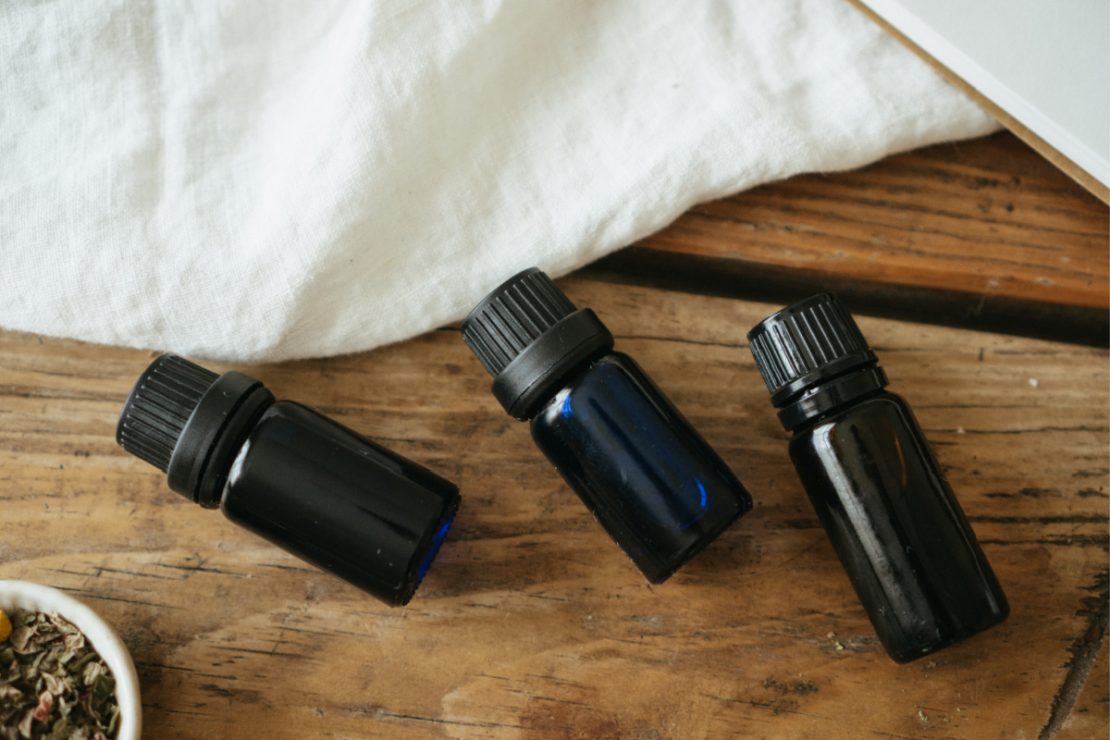
Lavender, Lemon, and Peppermint Essential Oils: Boring? Or Powerful Allies?
Do you ever feel that your retailer or favorite essential oil blogger is always touting the benefits of new essential oils you have not heard of or, at least, do not own? We may or may not know much about the oil other than what the retailer or blogger claims, but the advertising makes it sound so enticing—we simply have to buy it, just in case we need it someday. We all know that sweet siren song of, “Buy me. I smell wonderful, and I will be your best wellness friend!”
But what about those essential oils you already have? What about the sweet orange (Citrus x sinensis), lemon (Citrus x limon), lavender (Lavandula angustifolia), peppermint (Mentha x piperita), and eucalyptus (Eucalyptus radiata) sitting on your shelf? Is this new oil better than those dear friends you have had for years?
There are a couple of reasons to hold off on that impulse buy calling your name. First, while there are times the new oil may be precisely that combination of constituents that addresses a unique need you have, you may actually already have what you need and what is truly best for you. Second, one should not collect essential oils, although many of us find ourselves doing so. They have a finite shelf life, so one should only buy what one will use within approximately one year. Additionally, many of these essential oils are wildcrafted, putting tremendous pressure on wild plant populations; some of these plants are either already endangered and many have sustainability concerns. Be sure you need that beautiful new oil before clicking “buy.”
But if advertising does its job, it drives our brains to do things we may otherwise not choose to do. Our brains learn by making connections, although sometimes those connections blind us instead of enlightening us. For example, we often equate “natural” with “safe.” We sometimes connect “can be used with children” with “less effective.” We often connect “unique” with “special,” whether in a positive or negative context. We equate “cheaper” with “poor quality,” although we all know that is not always the case. We often equate “new” with “better.” There are examples to negate each of these fallacious linkages. For instance, arsenic exists naturally in the same areas as gold, yet having arsenic in water is not safe. Ibuprofen can be used with children, yet we know it is highly effective for adults as well. we need to be aware of these misconceptions because they are easy assumptions to make.
Lavender (Lavandula angustifolia), lemon (Citrus limon), and peppermint (Mentha x piperita) were probably among the first essential oils you purchased. They are old standards and trusty friends. They are relatively safe (not less effective), relatively inexpensive (not poorer quality), ubiquitous, and address multiple issues. We often take these essential oils for granted. Still, I would like to take a moment to remind you of just how wonderful they are. I hope you will consider these old friends as dependable standards or tried and true pillars in your essential oil collection, not as training wheels you only use before you learn to use other, “better” essential oils. Let’s look at what staples lavender, lemon, and peppermint essential oils can do for us.
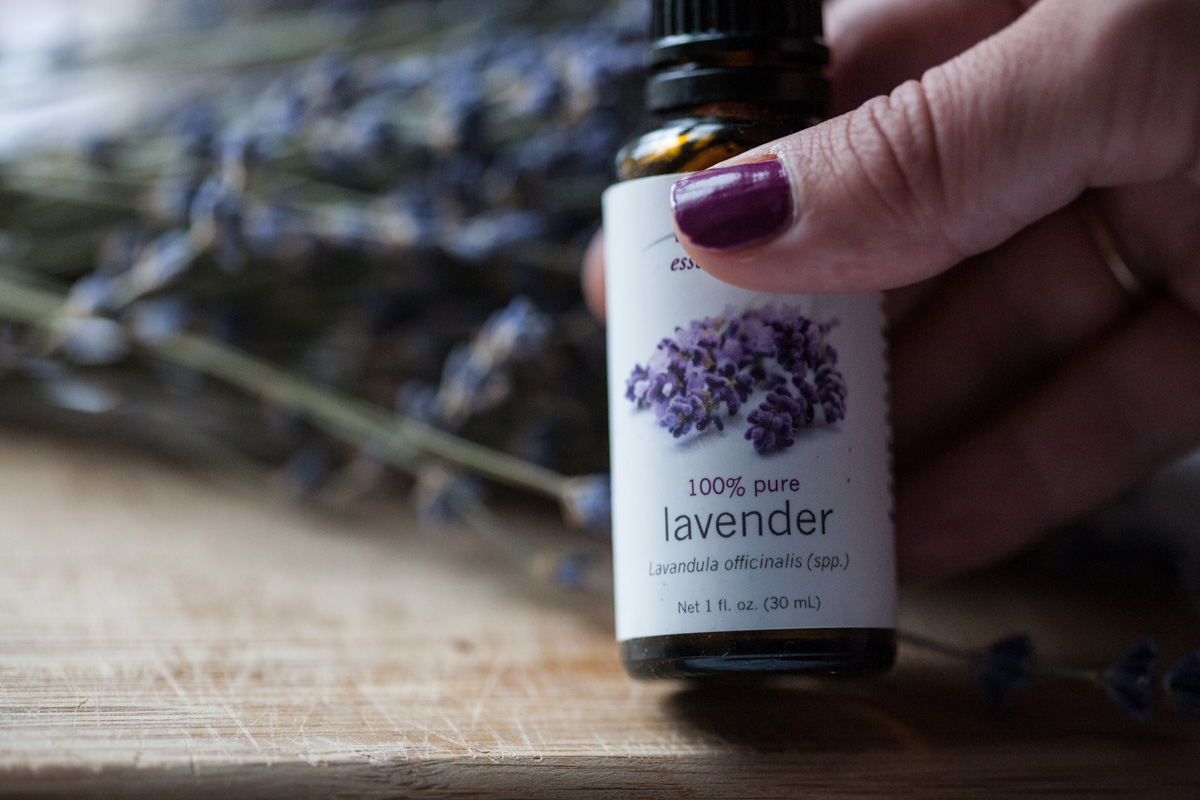
Lavender, Lemon, and Peppermint Essential Oils
Lavender (Lavandula angustifolia), often nicknamed “the Swiss army knife of aromatherapy,” referring to its apparent ability to address any issue, is often the first essential oil we get to know. Both traditional use and science have provided us with enough information about lavender and its constituents to feel well-acquainted with its beneficial properties and safety profile. It is pain-reducing, calming (blood pressure, muscle spasms, nervous system, and emotions), anti-inflammatory, antiseptic, antibacterial, antiviral, skin-regenerating, decongestant, deodorant, antifungal, and wound-helping. Lavender is able to address every system in the body in some manner (Battaglia, 2018; Holmes, 2016). It is probably most famous for its calming effects on the nervous system, especially in soothing headaches, countering stressful feelings, and encouraging sleep (Price & Price, 2012; Hargis, 2015).
In Chinese medicine, lavender is yin-nourishing and shen-calming. It is neutral-to-cool and clears heat, making it perfect for those chronic conditions that are hot and tense (Holmes, 2016). Ayurvedic practitioners use lavender for many of the above-listed conditions as well as to promote hair regrowth, as an insect repellent, and to encourage sleep (My, n.d.). It also balances all three Doshas (Spillane, 2021).
Lavender essential oil does not irritate skin and is non-sensitizing (Holmes, 2016; Tisserand & Young, 2014). However, it oxidizes easily, and as oxidized oils can irritate the skin, refrigerated storage is advisable. It is non-toxic, with an LD50 for mice of 2 g/kg body weight (Mekonnen et al., 2019). It is safe to use (inhalation and topical) with young children, the elderly, and during pregnancy (Tisserand & Young, 2014).
Lavender is one of the few essential oils sold over the counter in a commercially formulated supplement for emotional calming. The developers and other scientists have established a safe, effective dose for this product (Kasper et al., 2018; Seifritz et al., 2021).
Lemon (Citrus limon) has a fresh, invigorating aroma we often associate with summer, clean homes, throat soothing, and sunshine. It has a reputation in both traditional and scientific circles for being antimicrobial, antifungal, antispasmodic, astringent, a digestive aid, diuretic, emotionally uplifting, calming to heightened emotions, and an overall tonic (Battaglia, 2018).
Chinese medicine uses lemon to raise and clear yang and strengthen shen. Although lemon is cool, it can also resolve damp (Holmes, 2016). Ayurveda uses lemon for Vata and Kapha dosha for its uplifting, bright, warming, and stimulating qualities (Spillane, 2021).
Two processes create lemon essential oil—expression and steam distillation. Both processes produce essential oils that are safe for everyone, including special populations (e.g., children, elderly, those who are taking prescription medications, etc.), through all three methods of use (inhalation, topical, and internal). The one significant exception is that expressed lemon essential oil is mildly phototoxic and should be applied topically at a maximum concentration of 2% to any skin that will be exposed to UV radiation within the following 12-18 hours (Tisserand & Young, 2014). Lemon oil also oxidizes easily, contributing to its relatively short shelf life, and it should be stored in the refrigerator.
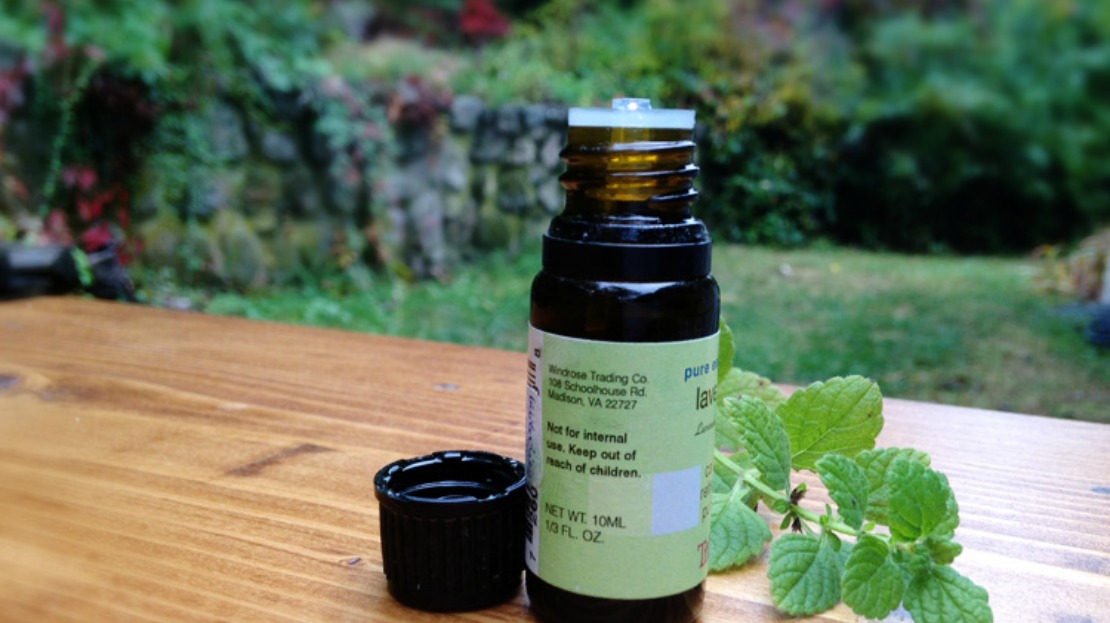
Peppermint (Mentha x piperita) is invigorating, reminding us of winter holidays, ice, cool breezes, and fresh breath. Some of its best-known useful activities are that it is analgesic, emotionally uplifting, antifungal, anti-itch, a digestive aid, decongestant, a nervous system stimulant, and a vasoconstrictor. Applying peppermint directly to painful areas (headache, stiff joints, sore muscles, bruises, insect bites) can ease pain and itchiness. Peppermint is a familiar ally against dyspepsia, flatulence, diarrhea, and nausea (Battalia, 2018).
In Chinese medicine, peppermint primarily reduces qi stagnation, clears yang deficiencies, and strengthens the shen (Holmes, 2016). In Ayurveda, peppermint is cooling and calming for Pitta dosha, and it can also be stimulating for Kapha dosha (Spillane, 2021).
Like lavender, peppermint essential oil is an ingredient in several over-the-counter supplements, especially for IBS (Irritable Bowel Syndrome). Several studies have demonstrated the positive effect enteric-coated peppermint essential oil capsules can have on IBS symptoms (Alammar et al., 2019). However, peppermint essential oil has some contraindications and safety concerns (see below); use it with appropriate caution.
Peppermint has the most complex safety guidelines of the three essential oils in this article.
- It can be mildly irritating to mucous membranes and the skin, with a recommended maximum topical concentration of 5.4%.
- Do not use peppermint in the bath.
- Those who suffer from gastroesophageal reflux disease (GERD) or cholestasis should not take peppermint orally.
- Peppermint essential oil use is contraindicated via all routes for cardiac fibrillation and G6PD deficiency.
- Do not apply or use peppermint near the faces of young children (Tisserand & Young, 2014). Tisserand recommends avoiding peppermint altogether with children under age three and diffusing it or applying it with a maximum topical concentration of 0.5%, still keeping it away from a child’s face, for ages 3-6 years (Tisserand, n.d.).
A note on commercial essential oil supplements designed for oral use:
- Current commercial oral essential oil preparations are designed for and tested on adults. Do not use them with children.
- Oral use of essential oils is more likely to cause internal toxicities and disrupt normal drug metabolism. If you take prescription medications, be extra cautious, especially with peppermint essential oil.
- Only take essential oils internally when under the supervision of someone with specific training that includes both the pharmacokinetics (movement of chemicals in the body) and pharmacodynamics (chemical actions within the body) of essential oils. When choosing an essential oil supplement, always carefully research the actions and safety of the supplement itself, your retail sources, and the specific supplement brands you plan to use.
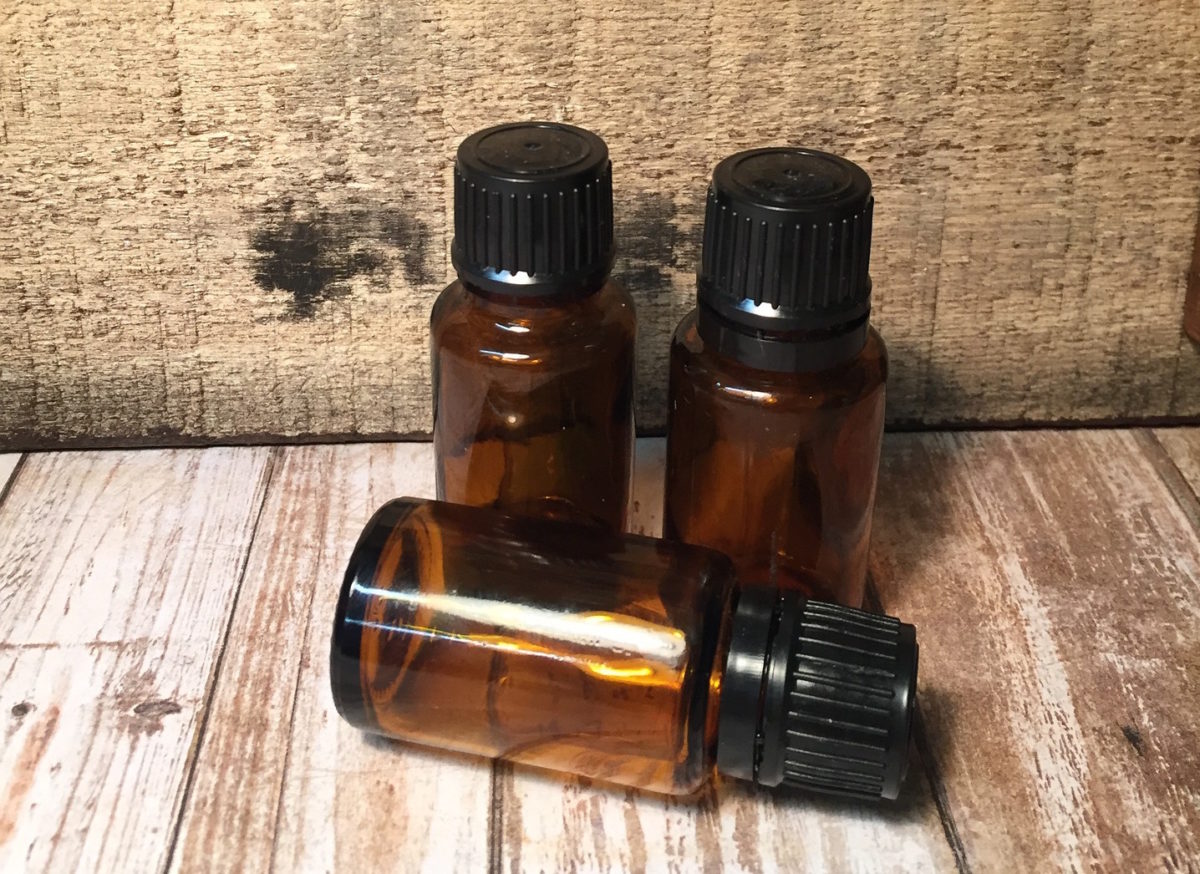
Powerful Tools with Known Safety Parameters
Have you noticed something here about the balance of beneficial actions to safety concerns for each of these oils? We know a lot about these three essential oils through traditional use and scientific study, and we know a lot about their actions as well as their safety concerns. We know how to use them for most populations in a broad spectrum of situations. Although peppermint has contraindications, as listed above, it is safe to use during pregnancy, both through inhalation and topical application. As a matter of fact, all three of these essential oils are safe to use during pregnancy.
When it comes to the populations we usually use extra caution within aromatherapy, pregnant people and children top the list. You should not use peppermint with children under age three and should use it in a very diluted form and with great care for children three years old and up. Other than that, these three oils are all helpful for children and during pregnancy. That alone tells us how precious and vital these essential oils are and why we should have them on hand as cornerstones of our essential oil cabinets.
In Closing,
Itchy or painful insect bites or stings? We have lavender and peppermint. Need an insect repellent? We have lavender and peppermint. Headaches? We have lavender and peppermint. Nausea or stomach aches? We have lemon and peppermint. Feeling down? We have lavender, lemon, and peppermint. Hay fever? Stuffy nose? We have lavender and peppermint. Lack of energy? We have lemon and peppermint. Not sleeping well? We have lavender. Feeling sluggish? We have lemon and peppermint. Need to clean the house? We have lavender, lemon, and peppermint. If you have these three oils, you can use one or more to address most daily concerns with every member of your family and friends. These essential oils may be familiar, easy to acquire, less expensive, and ubiquitous. However, they are also potent allies that are never boring or outdated.
Related reading:
How to choose the right lavender essential oil https://theherbalacademy.com/right-lavender-essential-oil/
Lavender essential oil: A must-have for every natural medicine chest https://theherbalacademy.com/lavender-essential-oil/
The benefits of lavender in the family home https://theherbalacademy.com/the-benefits-of-lavender-in-the-family-home/
Lavender/lemon window cleaner https://aromaticstudies.com/lavender-lemon-window-cleaner/
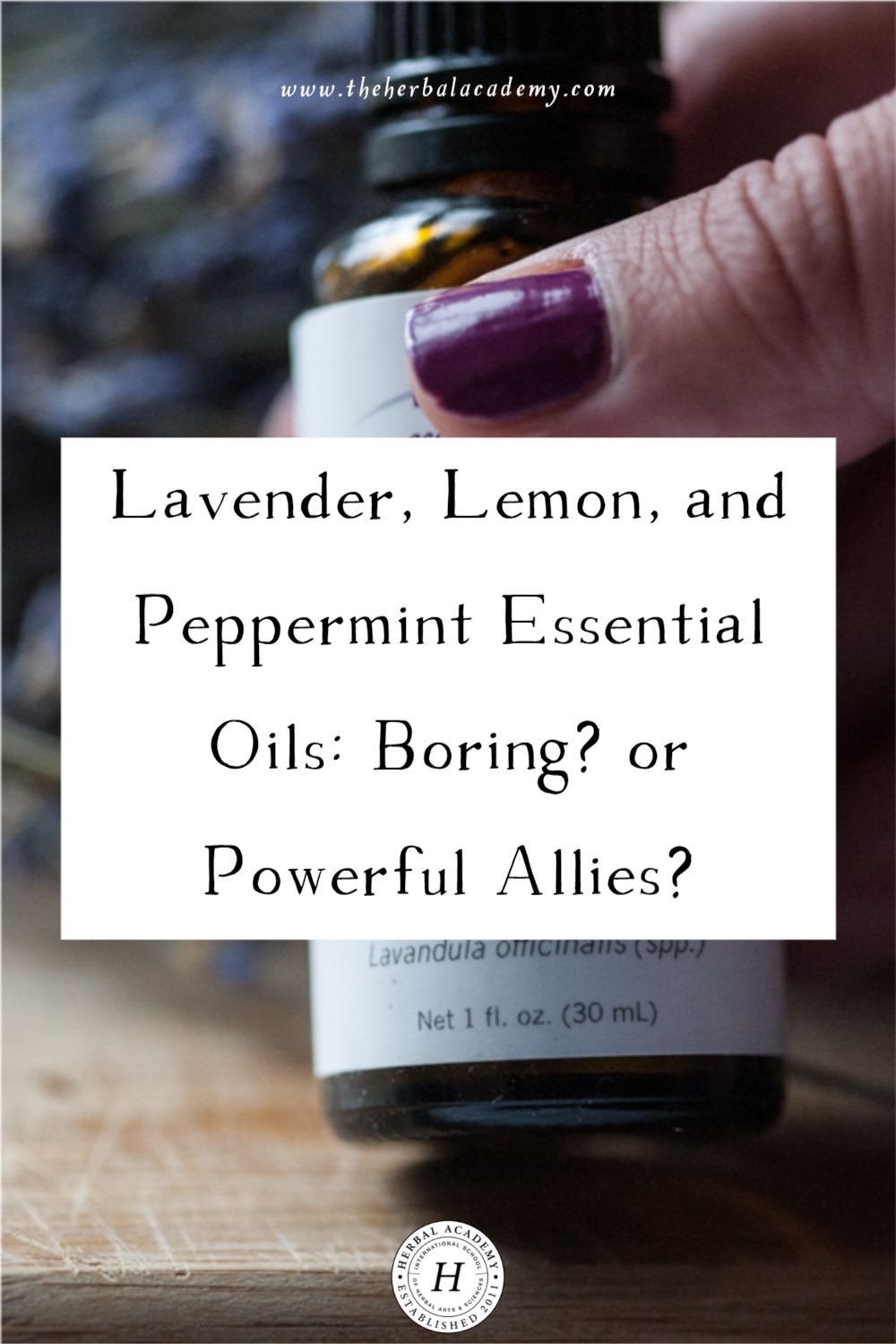
REFERENCES
Alammar, N., Wang, L.., Saberi, B., Nanavati, J., Holtmann, G., Sinohara, R. T., & Mullin G. E. (2019). The impact of peppermint oil on the irritable bowel syndrome: A meta-analysis of pooled clinical data. BMC Complementary and Alternative Medicine, 19(21). https://doi.org/10.1186/s12906-018-2409-0
Battaglia, S. (2018). The complete guide to aromatherapy (3rd ed.). (Vol 1). Black Pepper Creative.
Hargis, L. (2015). Common scents, a practical guide to aromatherapy (revised edition). French Kitchen Table Publishing.
Holmes, P. (2016). Aromatica: A clinical guide to essential oil therapeutics (Vol 1). Singing Dragon.
Kasper, S., Müller, W.E., Volz, H.-P., Möller, H.-J., Koch, E. & Dienel, A. (2018) Silexan in anxiety disorders: Clinical data and pharmacological background. The World Journal of Biological Psychiatry, 19(6), 412-420. https://doi.org/10.1080/15622975.2017.1331046
Mekonnen, A., Tesfaye, S., Christos, S.G., Dires, K. Zenebe, T., Zeheye, N., Shiferaw, Y., & Lulekal, E. (2019). Evaluation of skin irritation and acute and subacute oral toxicity of Lavandula angustifolia essential oils in rabbit and mice. Journal of Toxicology, 2019 (Article ID 5979546). 8 pages. https://doi.org/10.1155/2019/5979546
My, H. (n.d.) 10 amazing uses of lavender oil. Easy Ayurveda. https://www.easyayurveda.com/2016/08/30/uses-of-lavender-oil/amp/
Price, P. & Price S. (2012). Stress, depression and critical care. In S. Price & L. Price (Eds.), Aromatherapy for health professionals (4th ed.) (pp. 221-235). Churchill Livingstone Elsevier.
Seifritz, E., Möller, H.-J., Volz, H.-P., Müller, W. E., Hopyan, T., Wacker, A., Schläfke, S., & Kasper, S. (2021). No abuse potential of Silexan in healthy recreational drug users: A randomized controlled trial. International Journal of Neuropsychopharmacology, 24(3), 171–180. https://doi.org/10.1093/ijnp/pyaa064
Spillane, R. (2021, March 23). Essential oils for your dosha. Saraswati Ayurveda. https://www.saraswatiayurveda.com/blog/2021/3/19/essential-oils-for-your-dosha
Tisserand, H. (n.d.). Are eucalyptus and peppermint oils safe for young children? Tisserand Institute. https://tisserandinstitute.org/learn-more/kids-inhalation-safety/
Tisserand, R., & Young, R. (2014). Essential oil safety (2nd ed.). Elsevier.








